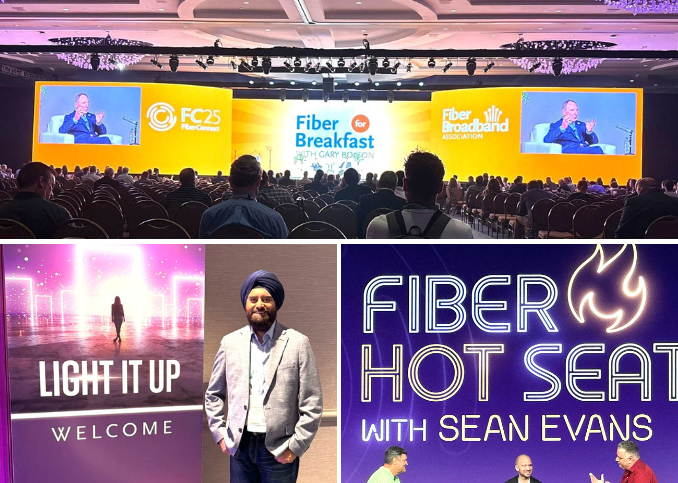Key Highlights from the Fiber Connect 2025 Event in Nashville
NEXSYS-ONE team participated in Fiber Connect 2025 | Fiber Broadband Association. Here is what we noted:
The Fiber Connect 2025 event, held in Nashville, proved to be an extremely valuable gathering for professionals across the fiber broadband industry. With over 5,000 attendees, the tradeshow brought together network operators, infrastructure providers, 5G carriers, and policy makers to explore advancements in fiber technology, market trends, and collaborative opportunities.
Advancements in Fiber Technology
Next-generation PON (Passive Optical Network)
A central theme at this year’s Fiber Connect was the evolution of PON technologies. Industry leaders like Nokia, Ciena, and Adtran unpacked the growing adoption of 25G and 50G PON systems, designed to address increasing bandwidth demands. These technologies promise faster speeds, better network capacity, and a future-proof infrastructure to meet the needs of both businesses and consumers.
Network Automation and AI
Automation took center stage in discussions, particularly the role of artificial intelligence (AI) and machine learning in streamlining network management. Companies highlighted how AI can optimize operations, predict maintenance needs, and improve overall network efficiency. With fiber deployments rising rapidly, automation is expected to play a dominant role in minimizing operational costs and enhancing service reliability.
Policy and Regulation
The Role of Government Support
Government initiatives aimed at enhancing fiber deployment were widely discussed. Updates on federal programs such as the $42 billion BEAD (Broadband Equity, Access, and Deployment) funding were shared, providing clarity on timelines and resource allocation. The Fiber Broadband Association (FBA) was praised for its leadership in mobilizing stakeholders, with meaningful participation from policymakers, including a keynote address by the Senator of Tennessee that underlined bipartisan support for closing the digital divide.
Rural Connectivity Prioritization
Expanding fiber networks in underserved rural regions remains a priority for the industry. Leaders from organizations like Choctaw Nation and Centranet shared success stories and strategies for increasing rural accessibility through public-private partnerships. These efforts are instrumental in bridging the digital divide and ensuring equitable internet access for all.
Emerging Market Trends
Integration with 5G
Speakers emphasized how fiber networks serve as the bedrock for 5G infrastructure. With technologies like Fixed Wireless Access (FWA) and Wi-Fi 7 gaining traction, the event explored how these solutions complement fiber broadband rather than replace it. This synergy is expected to redefine how enterprises and smart cities operate, underlining fiber’s indispensable role in the digital future.
Smart Cities and IoT Applications
Another noteworthy trend was the role of fiber in enabling smart city initiatives and IoT (Internet of Things) connectivity. From autonomous transportation to smart homes, fiber broadband is accelerating the adoption of advanced technologies designed to improve urban living standards and energy efficiency.
Sustainability at the Forefront
Green Fiber Deployment
Sustainability was a prominent theme throughout the event, with industry leaders sharing eco-friendly practices for fiber deployment. From using recyclable materials to deploying energy-efficient technologies, sustainability is becoming a core focus as telecom companies aim to reduce their environmental impact.
Industry Collaboration and Investment
Building Partnerships
Collaboration was a recurring subject, with successful partnerships between telecom companies, government agencies, and technology providers taking the spotlight. These alliances are proving critical in accelerating fiber deployment and fostering innovation across the sector.
Record-breaking Investments
Fiber broadband deployment in the U.S. has reached unprecedented levels, with 76.5 million homes passed by fiber as of 2025, marking a 13% year-over-year growth. Private equity has invested over $80 billion in fiber infrastructure over the past five years, with capital expenditures projected to reach $96 billion. While private equity currently funds 90% of deployments, public funding from initiatives like the BEAD program is expected to kick in by early 2026, further expanding the industry’s reach.
Why Fiber Connect Matters
Fiber Connect 2025 wasn’t just an event; it was a showcase of cutting-edge technologies, market trends, and collaborative efforts shaping the future of broadband. From breakthroughs in PON systems to robust rural connectivity strategies, the event emphasized fiber’s critical role in establishing a connected world.
A Call to Innovate and Collaborate
If you’re in the broadband industry, Fiber Connect 2025 served as a powerful reminder of the importance of innovation and collaboration. Whether you’re looking to adopt AI-powered automation, explore sustainable fiber deployments, or drive policy advocacy for rural connectivity, now is the time to act.
Need expert insights or tools to optimize your network? We invite you to explore opportunities to partner with leading fiber technology providers or join associations like the FBA to stay ahead of the curve in this rapidly evolving industry.

